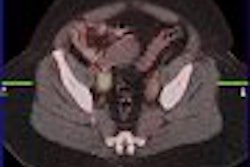PROVIDENCE, RI - A group of private and academic researchers is developing a multimodule cadmium zinc telluride (CZT) ring prototype for simultaneous MRI/SPECT preclinical imaging. While the technology is initially designed for animal imaging, it could ultimately be used for specific applications in humans, according to the research group.
"I believe this is the beginning of a new era in SPECT, that of stationary SPECT systems for both clinical and preclinical uses," said Douglas Wagenaar, director of research at Gamma Medica-Ideas of Northridge, CA. He offered a progress report on the system at the first annual joint conference of the Academy of Molecular Imaging (AMI) and Society of Molecular Imaging (SMI) in Providence, RI.
Gamma Medica-Ideas has partnered with the University of California, Irvine in Orange, CA, and Johns Hopkins University in Baltimore on the device, which could be operational by the end of this year.
"Ultimately, on the horizon, I think this (technology) will find clinical usefulness in cardiology," Wagenaar predicted. "The fact that we are putting CZT into the small bore of an animal MRI gives us impetus for the creation of smaller-pixel CZT, which we can do in order to get good performance at low magnifications in confined spaces."
Compatible modalities
Wagenaar noted that because MR and SPECT have relatively long acquisition times, together they achieve a "perfect registration or fusion" of images to facilitate cell tracking and other related applications.
The prototype consists of four rings of eight CZT modules each. CZT was chosen for the rings because it is MR-compatible, is of high-energy resolution for multiple-isotope imaging, and can reach 0.5-mm resolution in three directions to produce 3D volumetric resolution.
Collimators are used to zoom in on a 1-inch3 sphere for spot view tomography or whole-body tomography for dynamic SPECT.
CZT also allowed the group to develop a flexible circuit board for greater variability of the design. "I claim that we are entering a new era now, where detectors can be formed at the curved surfaces and the flexible circuit technology enables this capability, and arcs can be formed to give closer proximity," Wagenaar added. "You can imagine something like a biopsy or surgical scanner being arched around a surgical site."
Future plans
Differences in MR images have been noticed, depending on materials used for shielding and collimation. The team currently is evaluating mixtures of tungsten and polymer to see what works best for image quality.
"Right now we are fabricating many collimators of various compositions and testing them in the MR," Wagenaar said. "So far, we have made 13 sleeves and chosen a couple to do animal studies. They give us minimal artifacts near RF coils."
By the end of this year, the developers plan to have three CZT rings fully functional in the SPECT system. "Our future plans are to complete the single-ring test with an RF coil in an MR machine, acquire phantom and mouse images, and then fully complete the 24-module MR/SPECT system by the end of the year," he added.
By Wayne Forrest
AuntMinnie.com staff writer
September 10, 2007
Related Reading
Gamma Medica-Ideas to acquire AMI, November 28, 2006
Road to RSNA, Gamma Medica-Ideas, November 14, 2006
Gamma Medica-Ideas gets SPECT/MRI development grant, October 5, 2006
Gamma Medica-Ideas introduces eV-CZT digital gamma camera, August 30, 2006
Gamma Medica-Ideas shows Flex Triumph animal imager, June 7, 2006
Copyright © 2007 AuntMinnie.com




















